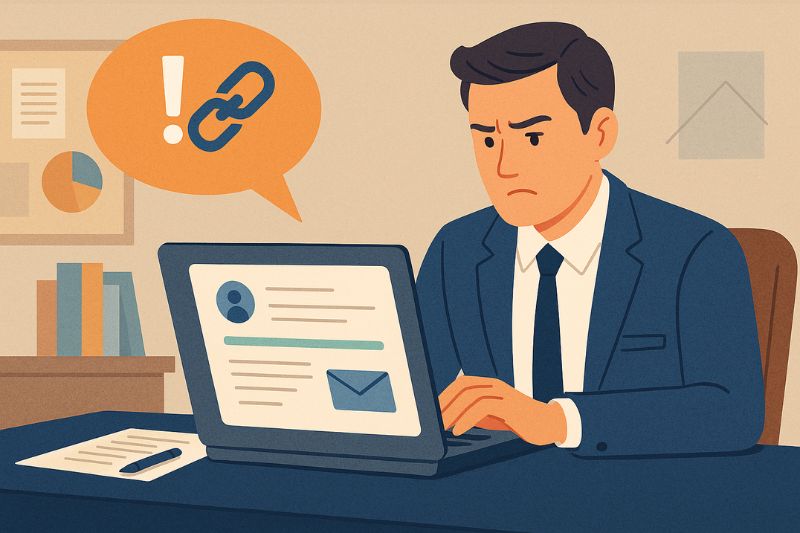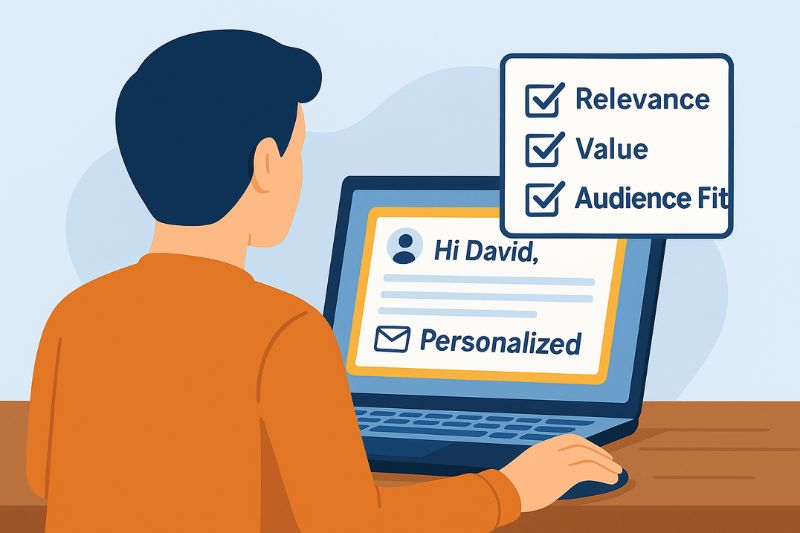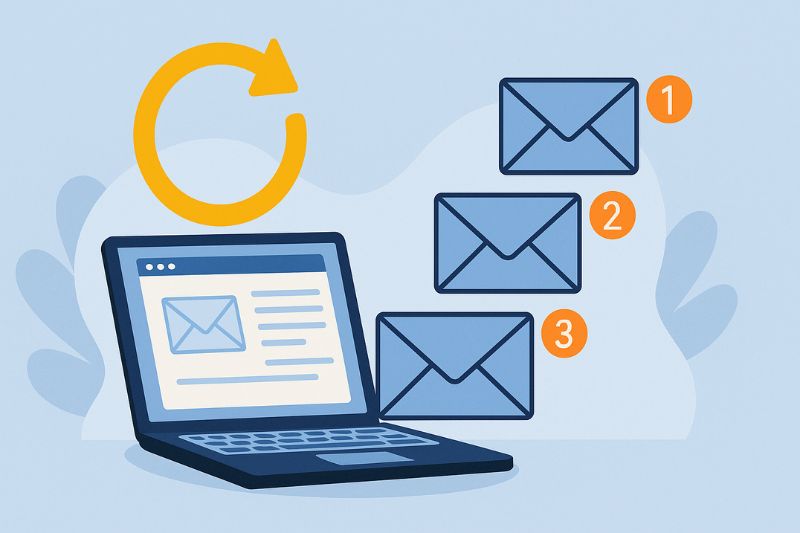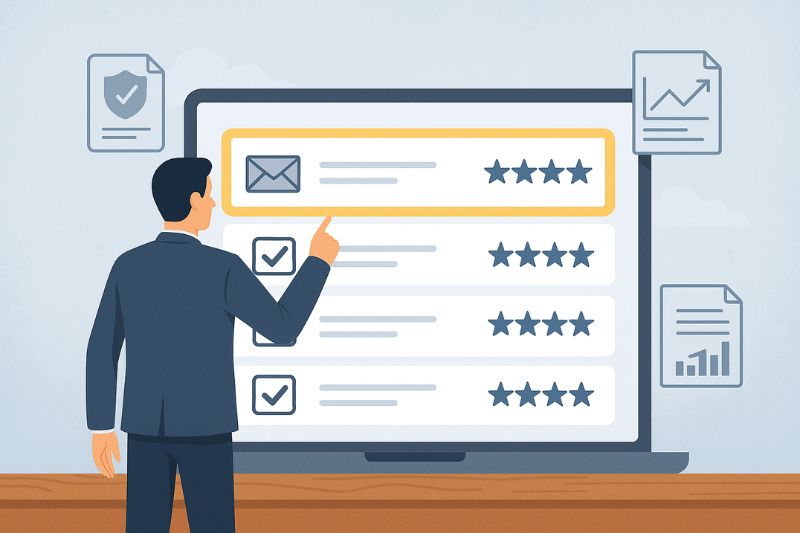About the author:
Darren Blumenfeld is the CEO and Founder of InboxAlly, an email deliverability platform trusted by growth-focused marketers. He’s previously founded HonestMail, worked at NASA, and holds degrees from Tufts and Columbia. His passion for tech, education, and creativity continues to inspire innovation in email outreach.
Cold email is a direct outreach method where a message is sent to someone with whom you have no prior contact, often to generate leads, build partnerships, or get feedback.
An effective cold email strategy includes personalisation, compliance, email warm-up, and follow-up sequencing. Cold emailing is low-cost, scalable, and versatile, ideal for startups, marketers, and recruiters.
This guide breaks down how to make cold emailing work, from when to use it to what to say and how to track success. Let’s begin!
When to Use Cold Email: 5 Real-World Scenarios
Cold email campaigns are useful any time you want to start a conversation with someone new. Whether you’re trying to increase sales, create new opportunities, or just learn a bit more about your target market, cold email is one of the most versatile tools to use.
Here are some of the most common areas where cold outreach works well:
1. Lead Generation
This is the most obvious use, and still the most powerful. Cold email lets you talk to potential customers directly and show them your offer by helping them understand how it solves a problem. It lets you qualify interest and move people into your pipeline while saving you money you’d otherwise spend on paid ads. You win by focusing on relevance: show that you understand their role or business and make your message worth reading.
2. Partnership Outreach
If you’re looking to build something with someone else, cold email can help you reach out to potential partners, whether you’re offering a referral arrangement, an affiliate program, or a co-branded campaign. An email that shows why the relationship makes sense for both of you can lead to long-term collaboration, even with people you’ve never met.
3. Hiring & Recruitment
You don’t always have to wait for candidates to come to you. Cold outreach can help you connect with talented people who might not be actively looking for a job but would consider one with the right opportunity. This works great, for example, in startups or companies that are looking to hire for niche roles. The more specific and personalised your email, the better your chances of getting a reply.
4. PR, Backlinks & Publicity
Whenever you want a journalist to cover your story or a blogger to link to your content, cold email is usually the first step. This type of outreach only works if it’s personalized and shows that you’ve read their work by explaining what’s in it for them and their audience.
5. Market Research
Cold email can also help you test new ideas, collect feedback, or validate a product before launch. You can send short surveys or ask direct questions to a relevant audience and learn what people care about and tweak your offer before investing more time or money.
![]()
Is Cold Email Effective? Pros and Cons Explained
Benefits of Cold Email Marketing
- Reaches highly targeted leads by role, company, or industry
- Costs less than ads or paid outreach; great for small budgets
- Easily scales with automation tools and templated messaging
- Provides instant feedback through opens, clicks, and replies
- Gets faster results than long-term SEO or content strategies
- Delivers high ROI with minimal upfront investment
- Works for multiple goals like sales, hiring, PR, and partnerships
Drawbacks of Cold Email Marketing
- Must comply with laws like GDPR and CAN-SPAM to avoid penalties
- Risk of hitting spam filters, especially with poor setup or volume spikes
- Low average reply rate—requires patience and consistent follow-ups
- Takes time to research, personalize, and craft quality messages
Getting Started: The Foundations of Cold Email Success
Identify Pain Points Before You Write
If there’s one thing that consistently improves cold email results, it’s talking directly to the recipient’s challenges. Most people won’t care about your product or service unless they feel like it solves something that’s already on their mind.
Before you begin to write cold emails, spend time understanding what your audience is struggling with. Look at industry news, read job posts, listen to podcasts, and check out LinkedIn. What’s making their work harder? What do they wish they could fix or do faster?
Once you know that, write your cold email with that specific pain point front and center. Instead of listing all your features, show how you’ve solved this same issue for others. Explain how you help, without overselling. When someone reads your message and feels like you “get it,” they’re far more likely to reply.
Remember: you’re offering a shortcut, a better path, or a way to solve something that’s already frustrating. That’s what creates interest and earns responses.
Find and Reach the Right Contact
It doesn’t matter how good your message is if it ends up in the wrong inbox. Reaching the right person (the one who actually makes decisions) is one of the most important parts of any cold email strategy.
Start by researching your audience. Look up the company on LinkedIn, explore their team page, or use tools that can help you figure out titles and roles. You want to avoid sending your email to someone who has no reason to care about what you’re offering.
Once you’ve found the right contact, make it personal. Use their name, mention something about their role, or refer to something recent they’ve done or posted. Even if you’re not sure they’re the exact right person, it’s okay to ask. A short message like “I’m not sure if you’re the best person to ask. If not, I’d appreciate you pointing me in the right direction” shows humility and respect for their time.
The more effort you put into getting this step right, the better your chances of starting a conversation that goes the way you want it.
Using Cold Email Templates
Cold email templates can be a great shortcut if you’re trying to build a day-to-day outreach process. They can save you a lot of time and give you a format to follow when you’re just starting or running campaigns at scale. But templates are only as good as the effort you put into personalising them.
The best cold email templates usually follow a simple formula:
- a subject line that gets attention, an opening that feels human and relevant,
- a short explanation of what you’re offering, and
- What the reader should do next.
That structure works, but copying it word-for-word doesn’t. If your message feels generic, people will often ignore it. If it feels like it could only have been written for them, they’ll be more likely to read and reply.
Templates should be treated like scaffolding. You start with a strong foundation, then adapt it to suit the person you’re contacting. That means tweaking your language based on how they speak, referencing something about their work or business, and showing how you can help. It also means trimming unnecessary info and keeping the message focused.
The real goal is to sound like a person, not like a robot or a salesperson. Even small custom touches can go a long way in making your cold email stand out in a crowded inbox.
Best Cold Email Practices for Higher Replies
Writing a cold email that generates business leads requires respectful engagement and value-driven communication with prospects. Here are some of the best cold email marketing practices used by experts:
1. Understand Your Prospect
To be successful in cold email marketing, you need to learn who you’re writing and sending to. So, ensure you research your prospects. Learn not just who they are but what they do. Have a good grasp of their needs and how your business could also help them.
2. Write a Compelling Subject Line
You need a catchy subject line for your cold email outreach to get read. It means a descriptive subject line, yet concise. It should also prompt the recipient to open the email.
So, make your subject lines not sales-y and add a touch of personalization. And this brings us to our next email marketing strategy.
3. Personalize Your Emails
Personalization is the secret ingredient to running a successful cold email campaign. It also shows your prospects that you know who you’re communicating with.
Therefore, spend time studying each potential client instead of using cliched opening statements. Check their LinkedIn profile or website and learn more about their current projects, successes, possible pain points, and objectives.
Personalized cold emails give your brand or company more authority. They will also be more likely to be read or replied to.
4. Segment Based on Engagement
Segmenting your recipients into groups based on their engagement level will be a game-changer. Aside from their levels of engagement, you can also group them based on their interests and problems.
In addition, doing so will make it easy for you to craft content specifically designated for every group and address their requirements and unique problems more effectively.
As a business, the relevance and value of your offers will skyrocket when you address your clients’ most pressing concerns. It will also positively impact your campaign, including higher conversion rates, greater trust, client loyalty, and positive word-of-mouth.
5. Keep Things Simple
Short and simple yet actionable cold emails usually get the best results. Most people don’t have much time to read complex emails.
So, establish a clear-cut, single purpose for sending the cold email to a target audience. Doing so will give your campaign the power to increase open and click-through rates.
There are also cold email templates you can use online as a baseline; ensure to edit them for your audience and their specific needs.
6. Proofread the Emails
Crafting a cold email with spelling and grammatical errors can derail your efforts and time for such a campaign. Even one mistake can signal a wrong impression to your prospects.
As such, you should prioritize proofreading your campaign before clicking the “send” button. Even if you’re using a cold email template, check and maintain a professional image to boost your chances of success.
7. End With a Strong Call-to-Action (CTA)
Include the CTA when you’re planning an effective cold email strategy.
Presenting a clear path to your recipient makes a strong CTA. It also makes it easy for the recipient to follow what you ask them to.
8. Timing
You can increase your chances of getting high open and response rates for your campaign if you send emails at the right time. Studies show that the best time to send a cold email is between 8 a.m. and 11 a.m., following the recipient’s time zone.
The reason for this marketing strategy is simple: most business professionals check their email first in the morning.
9. Add Follow-ups
Following up on our cold email outreach is essential in cold email marketing. Remember that the chance of getting a response to your first email could be higher, or recipients may completely ignore your email. It could be that they are busy or trapped by spam filters.
Therefore, follow-ups are always wise because you get to convey your message once more and educate them about how your service or product can solve their pain points.
10. Test and Optimize
Testing and optimizing your cold email campaign is necessary to know what’s working. You can experiment using A/B testing by sending emails with different email content, subject lines, and CTAs until you find the ideal combination that works well for your target market.
11. Always, always offer something valuable
If your cold email reads like an ad, it’s guaranteed to go in the trash. People don’t want another pitch (they’ve got so many!). They want valuable insights, or at least some evidence you’ve thought about them. That could be a short observation about their company website, a note about a job opening, or a connection to one of your existing customers.
Good cold emails are about genuine interest, not traditional advertising. You’re trying to start a conversation, not close a deal in the first paragraph. If you’re selling software, maybe the goal isn’t a signup but maybe a call, a reply, or more meetings down the line.
Get into the customer’s shoes. What kind of email would you like to get?
Avoiding Common Cold Email Mistakes
1. Spammy Subject Lines
Even experienced senders can get this wrong. The most common mistake is writing emails that feel like spam. That usually starts with a bad subject line; something vague, overly salesy, or just irrelevant. If it sounds like every other pitch in the inbox, you can bet people won’t open it.
2. Too Much Text
Be mindful of the length, too, and don’t send a wall of text. Your message should be short enough to skim but detailed enough to make the value clear. Aim for around 100–150 words. That’s enough space to introduce yourself, explain your offer, and ask for a quick next step.
Avoid jargon or complicated explanations. If someone has to reread your message to understand what you’re offering, you’ve probably lost them already. Be clear, direct and sound like a person.
3. No Clear CTA
Include a proper call-to-action, something simple like “Would it make sense to chat next week?” or “Open to a quick call?” You should also make it easy to unsubscribe or say no. If you can’t get a lead, you should always show respect.
4. Over-automation
And finally, don’t rely too heavily on automation. Personal touches are still important, even when using cold email software. The best campaigns are the ones that have a good balance between efficiency and human tone.
But, before you blame your copy, test your email with InboxAlly’s free email tester. It helps you identify technical issues that can kill performance, even if your message is spot on.
Nail the Subject Line (Or Nothing Else Matters)
No one reads a cold email with a boring subject line. If your subject line doesn’t catch the eye, it’s over. Good cold email subject lines are short, specific, and give the recipient a reason to click. Curiosity is powerful, but so is clarity.
There’s a difference between “Quick question” and “Quick question about [company name]’s marketing strategy.” One feels like spam, the other shows a genuine interest in the prospect’s business.
Testing your subject lines (along with preview text) should be part of every direct outreach campaign. Keep a doc of what works. The open rate will tell you when you’ve got it right.
How To Handle Follow-ups
Your initial cold email is just the opener. Most replies come after the second or third follow-up email, so if you’re only sending one, you’re leaving money on the table. The trick is to space them out, stay polite, and always offer value.
And yes, automated follow-ups are fine if done well. Tools like Mailshake or Instantly can help you create automated campaigns that feel personal with a bit of work. Just don’t send the same message three times.
Every follow-up should add something new, like an insight, a blog post, a stat, or a question that reminds the readers that you’re paying attention.
And no hard feelings if they don’t respond. Some people just aren’t interested. Move on.
Choosing the Best Cold Email Tool
Crafting and automating your campaign is easier with the right cold email tool or software. Email deliverability tools, like InboxAlly, offer robust analytics. So you know exactly the impact of your campaign and assess its performance.
The right cold email software will also optimize and streamline your email outreach efforts, making it a valuable tool for your sales team.
Here are some key factors to consider in choosing the right cold email tool or service:
| Factor | What to Look For |
| Deliverability | Look for high deliverability rates and tools that help with better inbox placement, even on new domains or cold IPs. |
| Features | Must-have tools have email automation, A/B testing, contact segmentation, and flexible sending schedules. |
| Reputation | Read customer reviews and see how often the service is flagged by email providers. |
| Compliance | Make sure the platform helps you comply with CAN-SPAM and GDPR laws. This includes opt-out handling and sender info. |
| Analytics & Reporting | Your tool should provide detailed stats on opens, clicks, and responses, ideally in real-time |
Conclusion
Now that you’ve learned how to write effective cold emails, what’s next?
Well, it’s time to craft a conversion-driven cold email campaign or make the necessary adjustments to your existing campaign.
And if your cold email outreach doesn’t take flight in the time you thought it would, don’t throw in the towel yet. Apply the insight from these cold email tips. Perhaps all you need is consistency and a little time to start seeing good results.
Good luck and happy prospecting!
InboxAlly is a unique email deliverability tool used by deliverability experts, mailing list owners, email service providers, and agencies. If you want to ensure your cold email campaign produces positive results, try us for free for 10 days.



